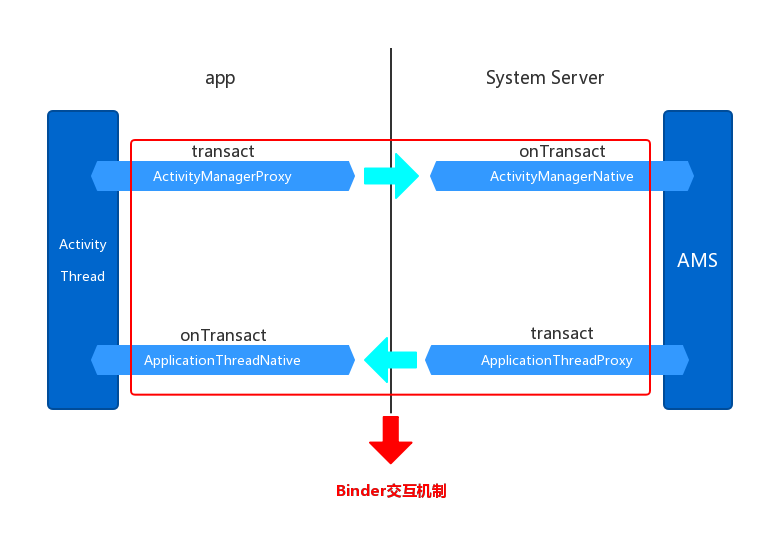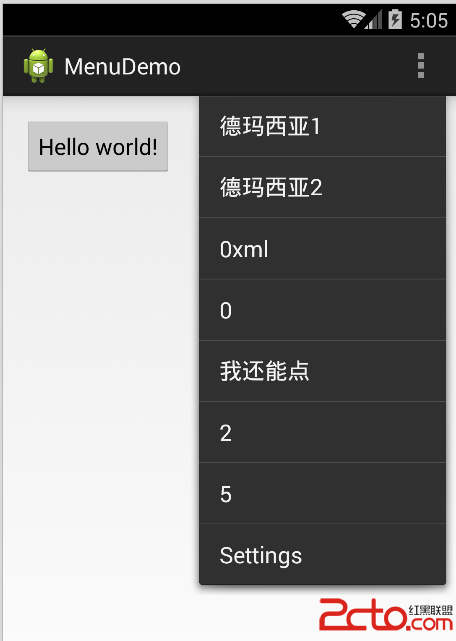編輯:關於Android編程
初始Custom View的構造函數
之前寫過一篇實現圓形進度條的博客(自定義圓形進度條),通常我們在實現Custom View的時候,都會先繼承View並實現View的三個構造函數,例如:
import android.content.Context;
import android.graphics.Canvas;
import android.util.AttributeSet;
import android.view.View;
public class MyCustomView extends View {
/**
* 第一個構造函數
*/
public MyCustomView(Context context) {
this(context, null);
}
/**
* 第二個構造函數
*/
public MyCustomView(Context context, AttributeSet attrs) {
this(context, attrs, 0);
}
/**
* 第三個構造函數
*/
public MyCustomView(Context context, AttributeSet attrs, int defStyle) {
super(context, attrs, defStyle);
// TODO:獲取自定義屬性
}
@Override
protected void onDraw(Canvas canvas) {
super.onDraw(canvas);
}
}
網上有很多關於三個構造函數使用時機的說法,但是說法正確的卻沒有幾家,這裡正式的給大家科普一下:
在代碼中直接new一個Custom View實例的時候,會調用第一個構造函數.這個沒有任何爭議.
在xml布局文件中調用Custom View的時候,會調用第二個構造函數.這個也沒有爭議.
在xml布局文件中調用Custom View,並且Custom View標簽中還有自定義屬性時,這裡調用的還是第二個構造函數.
也就是說,系統默認只會調用Custom View的前兩個構造函數,至於第三個構造函數的調用,通常是我們自己在構造函數中主動調用的(例如,在第二個構造函數中調用第三個構造函數).
至於自定義屬性的獲取,通常是在構造函數中通過obtainStyledAttributes函數實現的.這裡先介紹一下如何生成Custom View的自定義屬性.
生成Custom View的自定義屬性
Custom View添加自定義屬性主要是通過declare-styleable標簽為其配置自定義屬性,具體做法是: 在res/values/目錄下增加一個resources xml文件,示例如下(res/values/attrs_my_custom_view.xml):
<resources> <declare-styleable name="MyCustomView"> <attr name="custom_attr1" format="string" /> <attr name="custom_attr2" format="string" /> <attr name="custom_attr3" format="string" /> <attr name="custom_attr4" format="string" /> </declare-styleable> <attr name="custom_attr5" format="string" /> </resources>
在上述xml文件中,我們聲明了一個自定義屬性集MyCustomView,其中包含了custom_attr1,custom_att2,custom_attr3,custom_attr4四個屬性.同時,我們還聲明了一個獨立的屬性custom_attr5.
所有resources文件中聲明的屬性都會在R.attr類中生成對應的成員變量:
public final class R {
public static final class attr {
public static final int custom_attr1=0x7f010038;
public static final int custom_attr2=0x7f010039;
public static final int custom_attr3=0x7f01003a;
public static final int custom_attr4=0x7f01003b;
public static final int custom_attr5=0x7f010000;
}
}
但是聲明在標簽中的屬性,系統還會在R.styleable類中生成相關的成員變量:
public static final class styleable {
public static final int[] MyCustomView = {
0x7f010038, 0x7f010039, 0x7f01003a, 0x7f01003b
};
public static final int MyCustomView_custom_attr1 = 0;
public static final int MyCustomView_custom_attr2 = 1;
public static final int MyCustomView_custom_attr3 = 2;
public static final int MyCustomView_custom_attr4 = 3;
}
可以看出,R.styleable.MyCustomView是一個數組,其中的元素值恰好就是R.attr.custom_attr1~R.attr.custom_attr4的值.而下面的MyCustomView_custom_attr1~MyCustomView_custom_attr4正好就是其對應的索引.
知道了這些之後,我們就可以來學習一下,如何在Custom View的構造函數中獲取自定義屬性的值了.
在Custom View的構造函數中獲取自定義屬性
在第三個構造函數中獲取自定義屬性的代碼如下:
public MyCustomView(Context context, AttributeSet attrs, int defStyleAttr) {
super(context, attrs, defStyleAttr);
TypedArray ta = context.obtainStyledAttributes(attrs, R.styleable.MyCustomView);
String attr1 = ta.getString(R.styleable.MyCustomView_custom_attr1);
String attr2 = ta.getString(R.styleable.MyCustomView_custom_attr2);
String attr3 = ta.getString(R.styleable.MyCustomView_custom_attr3);
String attr4 = ta.getString(R.styleable.MyCustomView_custom_attr4);
Log.e("customview", "attr1=" + attr1);
Log.e("customview", "attr2=" + attr2);
Log.e("customview", "attr3=" + attr3);
Log.e("customview", "attr4=" + attr4);
ta.recycle();
}
關於自定義屬性的獲取,我們主要是調用了context.obtainStyledAttributes這個函數,相信這個函數大家自定義View的時候都用的很熟練了.我們來看一下這個函數的源碼實現:
public final TypedArray obtainStyledAttributes(AttributeSet set, @StyleableRes int[] attrs) {
return getTheme().obtainStyledAttributes(set, attrs, 0, 0);
}
通過對源碼的追蹤,我們發現context的兩個參數的obtainStyledAttributes方法最終是調用了Theme的4個參數的obtainStyledAttributes方法.我們來看一下這個函數的源碼實現:
public TypedArray obtainStyledAttributes(AttributeSet set,
@StyleableRes int[] attrs, @AttrRes int defStyleAttr, @StyleRes int defStyleRes) {
final int len = attrs.length;
final TypedArray array = TypedArray.obtain(Resources.this, len);
// XXX note that for now we only work with compiled XML files.
// To support generic XML files we will need to manually parse
// out the attributes from the XML file (applying type information
// contained in the resources and such).
final XmlBlock.Parser parser = (XmlBlock.Parser)set;
AssetManager.applyStyle(mTheme, defStyleAttr, defStyleRes,
parser != null ? parser.mParseState : 0, attrs, array.mData, array.mIndices);
array.mTheme = this;
array.mXml = parser;
if (false) {
int[] data = array.mData;
System.out.println("Attributes:");
String s = " Attrs:";
int i;
for (i=0; i<set.getAttributeCount(); i++) {
s = s + " " + set.getAttributeName(i);
int id = set.getAttributeNameResource(i);
if (id != 0) {
s = s + "(0x" + Integer.toHexString(id) + ")";
}
s = s + "=" + set.getAttributeValue(i);
}
System.out.println(s);
s = " Found:";
TypedValue value = new TypedValue();
for (i=0; i<attrs.length; i++) {
int d = i*AssetManager.STYLE_NUM_ENTRIES;
value.type = data[d+AssetManager.STYLE_TYPE];
value.data = data[d+AssetManager.STYLE_DATA];
value.assetCookie = data[d+AssetManager.STYLE_ASSET_COOKIE];
value.resourceId = data[d+AssetManager.STYLE_RESOURCE_ID];
s = s + " 0x" + Integer.toHexString(attrs[i])
+ "=" + value;
}
System.out.println(s);
}
return array;
}
這裡就不做過多的源碼講解,而是把這四個參數的含義解釋給大家:
AttributeSet set: 屬性值的集合.
int[] attrs: 我們自定義屬性集合在R類中生成的int型數組.這個數組中包含了自定義屬性的資源ID.
int defStyleAttr: 這是當前Theme中的包含的一個指向style的引用.當我們沒有給自定義View設置declare-styleable資源集合時,默認從這個集合裡面查找布局文件中配置屬性值.傳入0表示不像該defStyleAttr中查找默認值.
int defStyleRes: 這個也是一個指向Style的資源ID,但是僅在defStyleAttr為0或者defStyleAttr不為0但Theme中沒有為defStyleAttr屬性賦值時起作用.
由於一個屬性可以在很多地方對其進行賦值,包括: XML布局文件中、decalare-styleable、theme中等,它們之間是有優先級次序的,按照優先級從高到低排序如下:
屬性賦值優先級次序表:
在布局xml中直接定義 > 在布局xml中通過style定義 > 自定義View所在的Activity的Theme中指定style引用 > 構造函數中defStyleRes指定的默認值
為了讓大家有更清楚更直觀的了解,再接下來設置自定義屬性的章節中,我將對custom_attr1~4這4個屬性分別在上述四個地方進行定義,然後在Custom View的構造函數中獲取它的值,從而看一下,優先級順序是否和我們預期的一樣.
設置自定義屬性值
以下的第幾個參數均是針對Resources.Theme類的obtainStyledAttributes四參數構造方法來說明的.
第二個參數——在布局xml文件中為屬性賦值
在設置自定義屬性之前,我們首先要在主Activity的布局文件中調用我們的Custom View,並且為其設置特定的屬性.
主布局文件內容如下:
<FrameLayout xmlns:android="http://schemas.android.com/apk/res/android" xmlns:custom="http://schemas.android.com/apk/res-auto" android:id="@+id/container" android:layout_width="match_parent" android:layout_height="match_parent"> <com.kevintan.eventbussample.view.MyCustomView android:id="@+id/id_custom_view" android:layout_width="400dp" android:layout_height="400dp" custom:custom_attr1="attr1_xml" /> </FrameLayout>
示例結果:
05-28 17:19:56.542 23575-23575/? E/customview: attr1=attr1_xml
05-28 17:19:56.542 23575-23575/? E/customview: attr2=null
05-28 17:19:56.542 23575-23575/? E/customview: attr3=null
05-28 17:19:56.542 23575-23575/? E/customview: attr4=null
注意:
在給自定義屬性賦值時,首先需要增加自定義屬性的命名空間,例如: xmlns:custom=”http://schemas.Android.com/apk/res-auto”,Android Studio推薦使用res-auto,在Eclipse中需要使用Custom View所在的包名: xmlns:cv=”http://schemas.android.com/apk/com.kevintan.eventbussample.view”
這裡,在布局文件中我們為custom_attr1賦值為: attr1_xml.自定義View中獲取該屬性值對應了getTheme().obtainStyledAttributes方法中的第二個參數@StyleableRes int[] attrs
第二個參數——在style中為屬性賦值
其次,自定義屬性還可以在Style中進行賦值.
首先,我們在xml布局文件中還為MyCustomView增加一個自定義的style,style代碼如下:
<style name="TestCustomView"> <item name="custom_attr1">attr1_style</item> <item name="custom_attr2">attr2_style</item> </style>
然後,我們修改布局文件,增加style字段:
<FrameLayout xmlns:android="http://schemas.android.com/apk/res/android" xmlns:custom="http://schemas.android.com/apk/res-auto" android:id="@+id/container" android:layout_width="match_parent" android:layout_height="match_parent"> <com.kevintan.eventbussample.view.MyCustomView android:id="@+id/id_custom_view" android:layout_width="400dp" android:layout_height="400dp" custom:custom_attr1="attr1_xml" /> </FrameLayout>
示例結果:
05-28 17:19:56.542 23575-23575/? E/customview: attr1=attr1_xml
05-28 17:19:56.542 23575-23575/? E/customview: attr2=attr2_style
05-28 17:19:56.542 23575-23575/? E/customview: attr3=null
05-28 17:19:56.542 23575-23575/? E/customview: attr4=null
這裡我們再次對custom_attr1屬性進行了賦值,同時我們對custom_attr2也進行了賦值.
小提示:
聰明的同學肯定都猜到我這樣賦值的作用了,但是還是要簡述一下:
對於custom_attr1,我們在xml布局文件、style、defStyle和theme中均進行賦值,那最終得到的結果必然能證實誰的優先級最高.
對於custom_attr2,我們在style、defStyle和theme中進行賦值,通過得到的結果我們能知道誰的優先級第二高.
對於custom_attr3和custom_attr4的賦值情況我就不多解釋了,我相信大家都懂得!!
同時,還需要大家注意的是,只要是layout布局文件中,無論是通過namespace直接為屬性賦值,還是通過style為屬性賦值,在構造函數獲取時都對應了getTheme().obtainStyledAttributes方法中的第二個參數@StyleableRes int[] attrs
第三個參數defStyleAttr
這個參數的意思是:
原文: An attribute in the current theme that contains areference to a style resource that supplies defaults values for the TypedArray. Can be 0 to not look for defaults.
翻譯: 這是當前Theme中的包含的一個指向style的引用.當我們沒有給自定義View設置declare-styleable資源集合時,默認從這個集合裡面查找布局文件中配置屬性值.傳入0表示不向該defStyleAttr中查找默認值.
為了測試該參數的作用和優先級,我們需要進行如下操作.
首先, 我們先聲明一個refrence格式的屬性, 用於表示style的引用.聲明在之前的res/values/attrs_my_custom_view.xml文件裡即可:
<attr name="MyCustomViewDefStyleAttr" format="reference"/>
然後,需要到AndroidManifest.xml中查看包含該自定義View的Activity所使用的主題是:
<activity> android:name="com.kevintan.eventbussample.MainActivity" android:theme="@style/AppTheme" android:label="@string/app_name" > <intent-filter> <action android:name="android.intent.action.MAIN" /> <category android:name="android.intent.category.LAUNCHER" /> </intent-filter> </activity>
最後,在style.xml中的AppTheme主題下增加MyCustomViewDefStyleAttr的引用實現.
<style name="AppTheme" parent="android:Theme.Holo.Light.DarkActionBar"> <!-- Customize your theme here. --> <item name="MyCustomViewDefStyleAttr">@style/MyCustomViewDefStyleAttrImpl</item> </style> <style name="MyCustomViewDefStyleAttrImpl"> <item name="custom_attr1">attr1_defStyleAttr</item> <item name="custom_attr2">attr2_defStyleAttr</item> <item name="custom_attr3">attr3_defStyleAttr</item> </style>
代碼驗證,記住如果要使用obtainStyledAttributes方法的第三個參數, 就需要在第三個構造函數中顯示的調用getTheme()的obtainStyledAttributes方法.
public MyCustomView(Context context, AttributeSet attrs) {
// 為defStyleAttr進行賦值
this(context, attrs, R.attr.MyCustomViewDefStyleAttr);
}
public MyCustomView(Context context, AttributeSet attrs, int defStyleAttr) {
super(context, attrs, defStyleAttr);
TypedArray ta = context.getTheme().obtainStyledAttributes(attrs, R.styleable.MyCustomView, defStyleAttr, 0);
String attr1 = ta.getString(R.styleable.MyCustomView_custom_attr1);
String attr2 = ta.getString(R.styleable.MyCustomView_custom_attr2);
String attr3 = ta.getString(R.styleable.MyCustomView_custom_attr3);
String attr4 = ta.getString(R.styleable.MyCustomView_custom_attr4);
Log.e("customview", "attr1=" + attr1);
Log.e("customview", "attr2=" + attr2);
Log.e("customview", "attr3=" + attr3);
Log.e("customview", "attr4=" + attr4);
ta.recycle();
}
代碼中,有兩點需要大家注意:
我在第二個構造參數中已經對defStyleAttr進行了賦值,第三個構造參數直接使用傳入參數即可.
第三個構造參數中,我使用了getTheme()的obtainStyledAttributes方法來代替context的2個參數的obtainStyledAttributes構造方法.
示例結果:
05-28 17:19:56.542 23575-23575/? E/customview: attr1=attr1_xml
05-28 17:19:56.542 23575-23575/? E/customview: attr2=attr2_style
05-28 17:19:56.542 23575-23575/? E/customview: attr3=attr3_defStyleAttr
05-28 17:19:56.542 23575-23575/? E/customview: attr4=null
從結果可以看出,在主題中指定style引用的優先級是低於在xml中直接賦值和使用style字段的.
同時,我們還需要了解一點:
在Android系統中的控件,很多都在構造參數中使用了第三個參數,例如Button.這樣做的好處是: 當我們切換不同的主題時,Button的樣式也能隨之進行改變.
第四個參數——通過defStyleRes為屬性賦值
這個參數的意思是:
原文: A resource identifier of a style resource that supplies default values for the TypedArray, used only if defStyleAttr is 0 or can not be found in the theme. Can be 0 to not look for defaults.
翻譯: 這是一個指向Style的資源ID,但是僅在defStyleAttr為0或者defStyleAttr不為0但Theme中沒有為defStyleAttr屬性賦值時起作用.
通過翻譯,我們可以明確兩點:
1.defStyleRes: 指向一個style引用.
2.defStyleRes的優先級低於defStyleAttr.
為了驗證,我們先在theme.xml文件中定義一個style:
<style name="MyCustomViewDefStyleRes"> <item name="custom_attr1">attr1_defStyleRes</item> <item name="custom_attr2">attr2_defStyleRes</item> <item name="custom_attr3">attr3_defStyleRes</item> <item name="custom_attr4">attr4_defStyleRes</item> </style>
然後,我們在自定義View的第三個構造函數中的obtainStyledAttributes函數中進行賦值,具體方法如下:
public MyCustomView(Context context, AttributeSet attrs) {
this(context, attrs, R.attr.MyCustomViewDefStyleAttr);
}
public MyCustomView(Context context, AttributeSet attrs, int defStyleAttr) {
super(context, attrs, defStyleAttr);
// 為defStyleRes進行賦值
TypedArray ta = context.getTheme().obtainStyledAttributes(attrs, R.styleable.MyCustomView, defStyleAttr, R.style.MyCustomViewDefStyleRes);
String attr1 = ta.getString(R.styleable.MyCustomView_custom_attr1);
String attr2 = ta.getString(R.styleable.MyCustomView_custom_attr2);
String attr3 = ta.getString(R.styleable.MyCustomView_custom_attr3);
String attr4 = ta.getString(R.styleable.MyCustomView_custom_attr4);
Log.e("customview", "attr1=" + attr1);
Log.e("customview", "attr2=" + attr2);
Log.e("customview", "attr3=" + attr3);
Log.e("customview", "attr4=" + attr4);
ta.recycle();
}
測試結果:
05-28 17:44:09.282 3137-3137/? E/customview: attr1=attr1_xml
05-28 17:44:09.282 3137-3137/? E/customview: attr2=attr2_style
05-28 17:44:09.282 3137-3137/? E/customview: attr3=attr3_defStyleAttr
05-28 17:44:09.282 3137-3137/? E/customview: attr4=null
重點:
如果大家認真的看實驗結果,肯定會被上面的結果感到奇怪,明明指定了defStyleRes,為什麼attr4的值還是null?
是因為之前講過defStyleRes的使用優先級:只有當defStyleAttr為0或者當前Theme中沒有給defStyleAttr屬性賦值時才起作用.
所以,這裡我們需要修改構造函數,將defStyleAttr設置為0.
public MyCustomView(Context context, AttributeSet attrs) {
// 為了驗證defStyleRes的作用,將defStyleAttr設置為0
this(context, attrs, 0);
}
public MyCustomView(Context context, AttributeSet attrs, int defStyleAttr) {
super(context, attrs, defStyleAttr);
TypedArray ta = context.getTheme().obtainStyledAttributes(attrs, R.styleable.MyCustomView, defStyleAttr, R.style.MyCustomViewDefStyleRes);
String attr1 = ta.getString(R.styleable.MyCustomView_custom_attr1);
String attr2 = ta.getString(R.styleable.MyCustomView_custom_attr2);
String attr3 = ta.getString(R.styleable.MyCustomView_custom_attr3);
String attr4 = ta.getString(R.styleable.MyCustomView_custom_attr4);
Log.e("customview", "attr1=" + attr1);
Log.e("customview", "attr2=" + attr2);
Log.e("customview", "attr3=" + attr3);
Log.e("customview", "attr4=" + attr4);
ta.recycle();
}
最終結果:
05-28 17:49:03.707 5772-5772/? E/customview: attr1=attr1_xml
05-28 17:49:03.707 5772-5772/? E/customview: attr2=attr2_style
05-28 17:49:03.707 5772-5772/? E/customview: attr3=attr3_defStyleRes
05-28 17:49:03.707 5772-5772/? E/customview: attr4=attr4_defStyleRes
後記
在文章結尾, 我們再次總結一下自定義屬性的屬性賦值優先級:
在布局xml中直接定義 > 在布局xml中通過style定義 > 自定義View所在的Activity的Theme中指定style引用 > 構造函數中defStyleRes指定的默認值.
以上就是本文的全部內容,希望對大家的學習有所幫助,也希望大家多多支持本站。
 Android Small插件化框架--啟動插件Activity源碼解析(下)
Android Small插件化框架--啟動插件Activity源碼解析(下)
AMS對startActivity請求處理及返回過程根據上一章的分析了解了調用startActivity(),終於把數據和要開啟Activity的請求發送到了AMS了,接
 Android Menu
Android Menu
OptionsMenu(選項菜單)1.重寫Activity的onCreateOptionsMenu(Menu menu)方法,在該方法裡調用Menu對象的方法來添加菜單項
 教你如何正確反編譯apk
教你如何正確反編譯apk
簡單的說下反編譯apk的流程:我們一般想要反編譯一個apk,無非就是想獲得三樣東西圖片資源 ,XML資源,和代碼資源一.圖片資源獲取、這個最簡單啦, &nbs
 Android開發之接收系統廣播消息
Android開發之接收系統廣播消息
BroadcastReceiver除了接收用戶所發送的廣播消息之外,還有一個重要的用途:接收系統廣播。如果應用需要在系統特定時刻執行某些操作,就